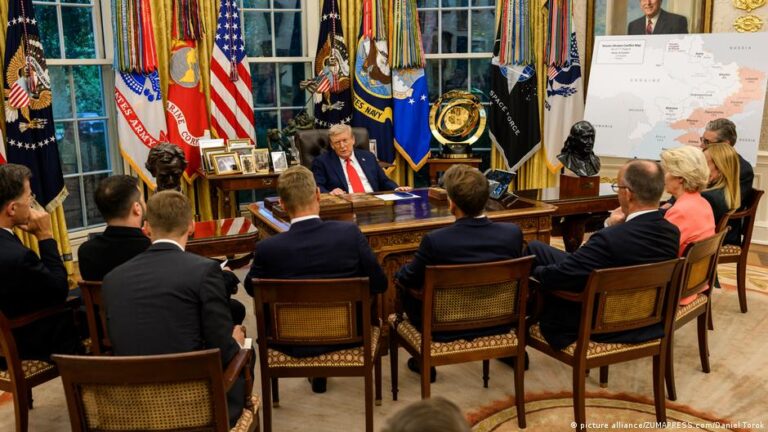Europeans are seething over US President Donald Trump’s suggestion that billions in Russian assets frozen in European countries may be used to the benefit of the US government and firms.
After a Trump proposal on how to end Russia’s war in Ukraine that called on Ukraine to give up territory and reduce the size of its armed forces, Europeans rushed to damage control and have now floated a counter offer.
“Every day with input it changes,” Secretary of State Marco Rubio said after meeting the Europeans on the sidelines of the G20 summit in Geneva.
But it is unclear if they will succeed in retaining control over how Russian frozen assets are spent.
Agathe Demarais, a senior policy fellow for geoeconomics at the ECFR, said billions in Russian assets appear to be Trump’s key motivation in pushing for a deal.
“Trump is extremely keen to get the billions,” she told DW.
What are Russian frozen assets and where are they held?
In 2022, when Russia invaded Ukraine, nearly 300 billion euros of its assets were lying outside Russia and were frozen as a result of western sanctions. These assets include bank accounts, securities, real estate and yachts.
While many countries hold these assets, including the United States, Canada, the UK and Japan, the largest chunk lies in EU member countries, and the largest of all in Belgium.
Euroclear, a Brussels based financial depository, holds roughly €180 billion in frozen Russian assets.
Since the war began Europeans have been discussing if and how to use Russian assets to make Russia pay for the war it began. The last such discussion was held in October, when Belgium vetoed a “reparations loan” that the EU wants to offer Ukraine to rebuild the nation.
But Belgium fears legal troubles and that it may be the one Russia will eventually asks for its money back from. That’s why Belgium refused to sign up and asked for the liability to be shared by other countries.
The EU expected to assuage Belgian concerns and win it over at an upcoming summit in mid-December. But Trump’s proposal has scuttled that plan and instead proposed what Demarais described as a proposal to “confiscate Russian assets lying in Europe.”
What does the Trump proposal, and the European counter proposal, say on frozen assets?
According to the US president’s 28-point proposal as reported in various media, 100 billion dollars (86 billion euros) in frozen Russian assets would be invested in “US-led efforts to rebuild and invest in Ukraine.” Or as Demarais put it: Trump intends to take the first €86 billion out of Russian assets frozen in Europe, and use that to profit both the US government and US companies.
In the plan it also says Europe would add the same amount to increase investment available for Ukraine’s reconstruction. This money that Trump wants Europe to contribute would not come from frozen Russian assets: “That will come out of European taxpayers’ pockets,” Demarais said.
The rest of the frozen funds, still more than €200 billion euros, would be invested in a joint US-Russian investment vehicle, “to create a strong incentive not to return to conflict.”
“This plan will benefit three entities- US companies, the US government and Russia,” Demarais said.
The counter proposal by the European powers of Germany, France and the UK, calls for the use of sovereign Russian money for Ukraine’s reconstruction. Moscow’s assets frozen in Europe “will remain frozen until Russia compensates damage to Ukraine,” according to the plan.
“This is a way to simultaneously move forward somehow, but not yet confiscate Russian assets,” Philip Bednarczyk, Warsaw office director with the German Marshall Fund (GMF) of the US, told DW.
“We are still [at an] in-between [point], but certainly in a much better place than what was proposed in the 28-point Trump plan — giving the US and Russia both a say in where those frozen assets could go without consulting the Europeans,” Bednarczyk said.
Can the US use Russian assets located in Europe for the benefit of US firms?
Jana Kobzova, Co-director of the European Security program at the European Council on Foreign Relations (ECFR), said the US “only holds about $5 billion” in frozen Russian assets and cannot decide how to use assets held in European countries.
“The US can only decide about assets held in its own jurisdiction,” she said.
In a paper for ECFR, Kobzova argued the Europeans must insist, “that European publics would accept the use of European-based Russian assets to stabilize Ukraine,” and backfill European spending on the country’s defense, “but it would be hard to accept that these will just generate mega-profits for American investors.”
European leaders have made their opposition to Trump’s plan clear.
“Russian assets based in Brussels cannot be paid out to the Americans, that is unthinkable,” Germany’s Chancellor Friedrich Merz told DW in an exclusive interview.
“The issues that concern, directly, the European Union, such as sanctions, enlargement or immobilized assets, require the full involvement in decisions by the European Union,” Antonio Costa, the EU council president, said.
French President Emmanuel Macron told French radio station RTL that only Europeans can decide what to do with assets that are held by Europeans.
Bednarczyk said principally the Europeans are not opposed to collaborating on a strategy with the US, and that under former president Joe Biden, they wanted to collectively decide how to deal with frozen Russian assets. But not anymore.
“The dynamics have changed,” Bednarczyk said. “Trump has much less regard for the European voice and often goes over Europe’s head.”
Experts argued it was time for the EU to get Belgium on board and move fast.
“If the EU were to seize the assets and issue loans to Ukraine, Trump won’t be able to get 300 billion euros anymore,” Demarais said.
Edited by: Carla Bleiker


